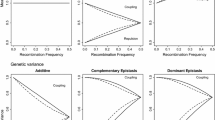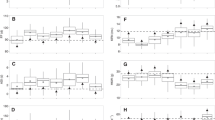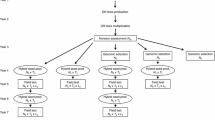Abstract
In hybrid maize (Zea mays L.) breeding, doubled haploids (DH) are increasingly replacing inbreds developed by recurrent selfing. Doubled haploids may be developed directly from S0 plants in the parental cross or via S1 families. In both these breeding schemes, we examined 2 two-stage selecting strategies, i.e., considering or ignoring cross and family structure while selection among and within parental crosses and S1 families. We examined the optimum allocation of resources to maximize the selection gain ΔG and the probability P(q) of identifying the q% best genotypes. Our specific objectives were to (1) determine the optimum number and size of crosses and S1 families, as well as the optimum number of test environments and (2) identify the superior selection strategy. Selection was based on the evaluation of testcross progenies of (1) DH lines in both stages (DHTC) and (2) S1 families in the first stage and of DH lines within S1 families in the second stage (S1TC-DHTC) with uniform and variable sizes of crosses and S1 families. We developed and employed simulation programs for selection with variable sizes of crosses and S1 families within crosses. The breeding schemes and selection strategies showed similar relative efficiency for both optimization criteria ΔG and P (0.1%). As compared with DHTC, S1TC-DHTC had larger ΔG and P (0.1%), but a higher standard deviation of ΔG. The superiority of S1TC-DHTC was increased when the selection was done among all DH lines ignoring their cross and family structure and using variable sizes of crosses and S1 families. In DHTC, the best selection strategy was to ignore cross structures and use uniform size of crosses.

Similar content being viewed by others
References
Baker RJ (1984) Quantitative genetic principles in plant breeding. In: Gustafson JP (ed) Gene manipulation in plant improvement. Plenum Press, New York, pp 147–176
Bernardo R (1996) Best linear unbiased prediction of maize single-cross performance. Crop Sci 36:50–56
Bernardo R (2002) Breeding for quantitative traits in plants. Stemma Press, Woodbury, Minnesota, pp 152–156
Bernardo R (2003) Parental selection, number of breeding populations, and size of each population in inbred development. Theor Appl Genet 107:1252–1256
Bernardo R (2009) Should maize doubled haploids be induced among F1 or F2 plants? Theor Appl Genet 119:255–262
Berry DA, Lindgren BW (1996) Statistics. Duxberry Press, New York, p 371
Falconer DS, Mackay TFC (1996) Introduction to quantitative genetics, 4th edn. Longman Scientific and Technical Ltd, Essex, England, pp 184–194, 230–231
Gordillo GA, Geiger HH (2008) Alternative recurrent selection strategies using doubled haploid lines in hybrid maize breeding. Crop Sci 48:911–922
Johnson B (1989) The probability of selecting genetically superior S2 lines from a maize population. Maydica 34:5–14
Keuls M, Sieben JW (1955) Two statistical problems in plant selection. Euphytica 4:34–44
Knapp SJ (1998) Marker-assisted selection as a strategy for increasing the probability of selecting superior genotypes. Crop Sci 38:1164–1174
Longin CFH, Maurer HP, Melchinger AE, Frisch M (2009) Optimum allocation of test resources and relative efficiency of alternative procedures of within-family selection in hybrid breeding. Plant Breed 128:213–216
Longin CFH, Utz HF, Melchinger AE, Reif JC (2006a) Hybrid maize breeding with doubled haploids: comparison between selection criteria. Acta Agron Hung 54:343–350
Longin CFH, Utz HF, Reif JC, Schipprack W, Melchinger AE (2006b) Hybrid maize breeding with doubled haploids: I. One-stage versus two-stage selection for testcross performance. Theor Appl Genet 112:903–912
Longin CFH, Utz HF, Reif JC, Wegenast T, Schipprack W, Melchinger AE (2007) Hybrid maize breeding with doubled haploids: III. Efficiency of early testing prior to doubled haploid production in two-stage selection for testcross performance. Theor Appl Genet 115:519–527
Lush JL (1947) Family merit and individual merit as bases for selection. Part 1. Am Nat 81:241–261
Melchinger AE, Longin CFH, Utz HF, Reif JC (2005) Hybrid maize breeding with doubled haploid lines: quantitative genetic and selection theory for optimum allocation of resources. In: Proceedings of the Forty First Annual Illinois Corn Breeders’ School 2005, Urbana-Champaign, Illinois, USA, pp 8–21
R Development Core Team (2006) R: a language and environment for statistical computing. R Foundation for Statistical Computing. Vienna, Austria. ISBN 3-900051-07-0, http://www.R-project.org
Robson DS, Powers L, Urquhart NS (1967) The proportion of genetic deviates in the tails of a normal population. Genet Breed Res 37:205–216
Schnell FW (1982) A synoptic study of the methods and categories of plant breeding. Z Pflanzenzuecht 89:1–18
Toro MA, Nieto BM (1984) A simple method for increasing the response to artificial selection. Genet Res Camb 44:347–349
Toro MA, Nieto B, Salgado C (1988) A note on minimization of inbreeding in small-scale selection programmes. Livest Prod Sci 20:317-323
Toro M, Pérez-Encisco M (1990) Optimization of selection response under restricted inbreeding. Genet Sel Evol 22:93–107
Utz HF (1969) Mehrstufenselektion in der Pflanzenzüchtung. (In German) Arbeiten der Universität Hohenheim, vol 49. Verlag Eugen Ulmer, Stuttgart, Germany
Wegenast T, Longin CFH, Utz HF, Melchinger AE, Maurer HP, Reif JC (2008) Hybrid maize breeding with doubled haploids IV Number versus size of crosses and importance of parental selection in two-stage selection for testcross performance. Theor Appl Genet 117:251–260
Wricke G, Weber WE (1986) Quantitative genetics and selection in plant breeding. Walter de Gruyter, Berlin, New York, pp 172–194
Acknowledgments
This research was supported by funds from DFG, Grant No 1070, International Research Training Group “Sustainable Resource Use in North China” to T. Wegenast. The authors appreciate the editorial work of Dr. J. Muminović, whose suggestions considerably improved the style of the manuscript. We greatly appreciate the helpful comments and suggestions of the anonymous reviewers.
Author information
Authors and Affiliations
Corresponding author
Additional information
Communicated by H. Becker.
An erratum to this article can be found at http://dx.doi.org/10.1007/s00122-010-1428-0
Electronic supplementary material
Below is the link to the electronic supplementary material.
Rights and permissions
About this article
Cite this article
Wegenast, T., Utz, H.F., Longin, C.F.H. et al. Hybrid maize breeding with doubled haploids: V. Selection strategies for testcross performance with variable sizes of crosses and S1 families. Theor Appl Genet 120, 699–708 (2010). https://doi.org/10.1007/s00122-009-1187-y
Received:
Accepted:
Published:
Issue Date:
DOI: https://doi.org/10.1007/s00122-009-1187-y




